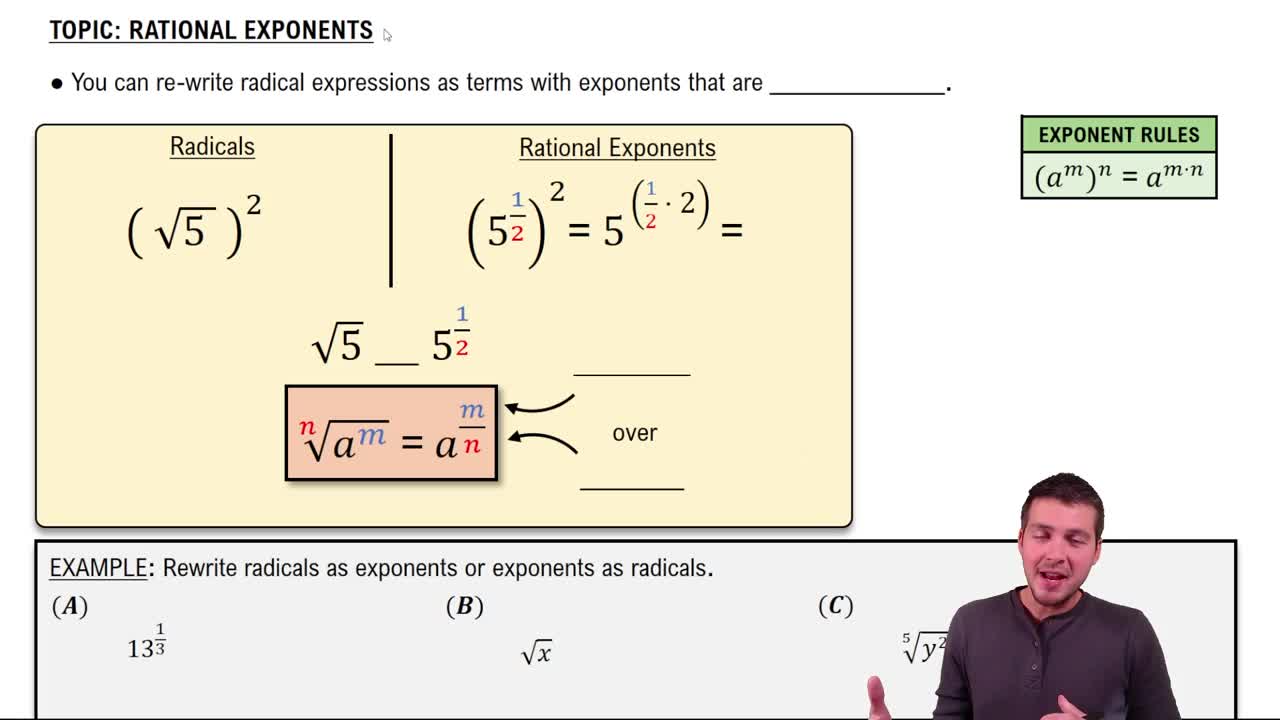Table of contents
- 0. Review of Algebra4h 16m
- 1. Equations & Inequalities3h 18m
- 2. Graphs of Equations43m
- 3. Functions2h 17m
- 4. Polynomial Functions1h 44m
- 5. Rational Functions1h 23m
- 6. Exponential & Logarithmic Functions2h 28m
- 7. Systems of Equations & Matrices4h 6m
- 8. Conic Sections2h 23m
- 9. Sequences, Series, & Induction1h 19m
- 10. Combinatorics & Probability1h 45m
6. Exponential & Logarithmic Functions
Properties of Logarithms
Problem 29b
Textbook Question
In Exercises 1–40, use properties of logarithms to expand each logarithmic expression as much as possible. Where possible, evaluate logarithmic expressions without using a calculator. log √(100x)
 Verified step by step guidance
Verified step by step guidance1
Recognize that the expression inside the logarithm is a square root, which can be rewritten as an exponent: \( \sqrt{100x} = (100x)^{1/2} \).
Apply the power rule of logarithms, which states \( \log_b(a^c) = c \cdot \log_b(a) \), to rewrite the expression as \( \frac{1}{2} \cdot \log(100x) \).
Use the product rule of logarithms, which states \( \log_b(mn) = \log_b(m) + \log_b(n) \), to expand \( \log(100x) \) into \( \log(100) + \log(x) \).
Combine the results from the previous steps to get \( \frac{1}{2} \cdot (\log(100) + \log(x)) \).
Evaluate \( \log(100) \) using the fact that \( 100 = 10^2 \), so \( \log(100) = 2 \cdot \log(10) \), and since \( \log(10) = 1 \), it simplifies to \( 2 \).
Recommended similar problem, with video answer:
 Verified Solution
Verified SolutionThis video solution was recommended by our tutors as helpful for the problem above
Video duration:
5mPlay a video:
Was this helpful?
Key Concepts
Here are the essential concepts you must grasp in order to answer the question correctly.
Properties of Logarithms
The properties of logarithms include rules that simplify the manipulation of logarithmic expressions. Key properties include the product rule (log_b(MN) = log_b(M) + log_b(N)), the quotient rule (log_b(M/N) = log_b(M) - log_b(N)), and the power rule (log_b(M^p) = p * log_b(M)). Understanding these properties is essential for expanding and simplifying logarithmic expressions.
Recommended video:

Change of Base Property
Radicals and Exponents
Radicals, such as square roots, can be expressed in terms of exponents. For example, √(a) can be rewritten as a^(1/2). This relationship is crucial when working with logarithmic expressions that involve roots, as it allows for the application of logarithmic properties to simplify the expression effectively.
Recommended video:
Guided course

Rational Exponents
Evaluating Logarithmic Expressions
Evaluating logarithmic expressions involves determining the value of the logarithm based on its definition. For instance, log_b(a) answers the question: 'To what power must b be raised to obtain a?' In the context of the given expression, understanding how to evaluate logarithms without a calculator can help in simplifying and expanding the expression accurately.
Recommended video:

Evaluate Logarithms

 3:49m
3:49mWatch next
Master Product, Quotient, and Power Rules of Logs with a bite sized video explanation from Callie
Start learningRelated Videos
Related Practice







